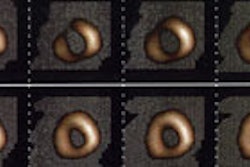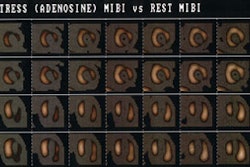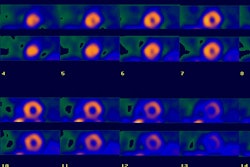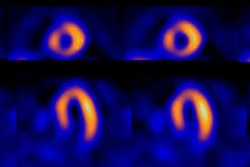Exercise ECG Testing
The human heart has a myocardial efficiency of 37%. In the resting state, the myocardium utilizes 8 to 10 mls per 100 grams of muscle per minute and coronary blood flow is about 60 mls/minute. Strenuous exercise in the upright position increases the cardiac output 4 to 6 fold to peak values of 240 mls/minute. Skeletal blood flow and oxygen extraction increase, total peripheral resistance decreases, and heart rate and systolic blood pressure increase as exercise progresses.
The accepted ECG criteria for the detection of occlusive CAD is the development of 1-mm horizontal or downsloping ST segment depression in at least 2 contiguous ECG leads [6]. The mean sensitivity of the exercise ECG for detecting CAD is about 50-68%, with a specificity of about 77-90% [6]. The sensitivity is higher in the face of three vessel or LAD disease, but is lower for RCA lesions. Note that between 5-10% of patients will only develop ECG evidence of ischemia during the recover phase of an exercise tredmill exam and the finding is associated with an adverse outcome compared to patients who have ischemia with exercise [19]. The exercise ECG has a lower sensitivity and specificity in women [3]. Up to 22% of pre-menopausal and 39% of post-menopausal women on hormone replacement therapy can have a positive ECG exam without evidence of ischemia on SPECT imaging [3]. The exact mechanism of ST-segment changes seen in women on hormone replacement therapy is unknown [3], but it may be due to a digoxin effect of estrogen. An estrogen-free period of 6 weeks should be sufficient to overcome this false-positive ECG response to exercise stress [3]. The sensitivity of the ECG exam is also diminished at submaximal exercise levels [5]. The level of exercise obtained influences the ECG exam more than the thallium exam. It is likely that flow heterogeneity is induced earlier during the course of exercise stress than the myocardial cellular alterations that mediate ST-segment depression [1]. In patients with known CAD the ability to exercise longer than 12 minutes (stage 4) on a Bruce protocol is associated with a better prognosis when compared to the inability to reach stage 3. Similarly, patients who achieve a heart rate over 160 have a greater survival rate than those who fail to achieve 120 bpm. [2] For patients who achieve > 10 MET's of exercise with no ischemic ST depression, SPECT imaging may not be necessary as these patients have a very low incidence of reversible defects on SPECT (and almost no ischemic compromising 10% of greater of the left ventricle) [8].
The usual rise in heart rate during exercise is thought to be
due to a combination of parasympathetic withdrawl
and sympathetic activation [7]. An abnormally low HR (blunted)
response to exercise is felt to be a marker of autonomic
dysfunction and a poor prognostic indicator [7,9]. Heart rate recovery from exercise
may also carry prognostic information [4]. A delayed decrease in
heart rate during the first minute after tredmill
testing appears to be an independent predictor of overall
mortality [4,7]. Normally, the heart
rate should decrease by at least 12 to 21
beats/minute one minute after cessation of peak
exercise [4]. Failure of the heart rate to decrease following
exercise is associated with a greater degree of ischemia on
perfusion imaging exams [4]. The delay in HR recovery is felt to
be a marker of reduced parasympathetic activity from the central
nervous system [7].
Exercise induced hypotension is commonly defined as a decraese
in syslotic BP during exercise below its resting or pre-test
value [20]. Other definitions include failure to increase by
more than 10 mm Hg from baseline or a decrease of more than 20
mm Hg after an initial risk [20]. A decline in systolic BP with
exercise is considered an ominous sign since it is associated
with LV systolic dysfunction and severe CAD, but even a modestly
decreased (<20 mmHg) systolic BP response to exercise is
associated with an increased risk for all-cause death and MI
[16]. Exercise induced hypertension at moderate exercise
intensity is also independently associated with increased
cardiovascular risk [16].
Exercise is the preferred method of stress for myocardial
perfusion imaging because exercise capacity has been shown to be
a stronger predictor of mortality than established
cardiovascular risk factors [5,12]. However, a diagnostic study
requires the patient exercise (Bruce, modified Bruce, or Naughton) for at least 6 minutes,
achieve a maximum heart rate of greater than 85% if maximum
predicted heart rate, and reach a perceived exertion level of
"hard" [5]. Submaximal exercise is
associated with decreased accuracy of the SPECT exam [5]. Some
authors feel that achievement of 85% MPHR is not a valid
endpoint because arbitrarily stopping the exam at that point
underestimates exercise capacity and can miss inducible ischemia
[11,12,18]. Up to 17% of patients who exercise more than 1
minute beyond 85% MPHR have a change in their Dukes Treadmill
Score risk assessment compared to that determined at 85% MPHR
(and an additional 38% of patients had positive ST segment
depression) [11]. Also- patients that exercise more than 1
minute beyond 85% MPHR are more likely to demonstrate perfusion
abnormalities on MPI [11]. Typical angina and/or significant
ST-segment depression, drop in blood pressure, or arrhythmias
have been considered for termination of exercise stress for
myocardial perfusion imaging on the basis that perfusion defects
occur earlier than angina and ST segment changes [124].
High exercise capacity alone is a strong predictor of good
prognosis and associated with a low risk of inducible ischemia
on MPI [15]. For intermediate risk CAD patients, achieving ≥ 10
METS of exercise (regardless of the heart rate) is associated
with a very low prevalence of
≥ 10% LV ischemia and very low rates of cardiac
events [10]. In one study, for patients that achieved more than
85% max predicted HR and over 10-METs, the prevalence of
significant ischemia (comprising 10% or more of the LV) was only
0.4% [13]. The prevalence of 5-9% LV ischemia was also very low
(0.7%) [13]. For patients that achieved equal to or more than
10-METs the annual cardiac mortality was 0.1% and the combined
annual cardiac death or non-fatal MI rate was 0.4% [13]. Some
authors suggest that myocardial perfusion imaging does not add
additional information in patients below the age of 65 years,
with no known CAD, an interpretatble resting ECG and no evidence
of exercise induced iscemia or arrhythmia on ECG, who attain
over 85% of the MPHR and at least 10-METs of exercise [13].
In another study of diabetic patients, those who achieved ≥ 5 METs during stress had significantly reduced risk for future cardiac events, even in the presence of significant perfusion defects [14]. Diabetic patients who achieve ≥ 10 METs have a very low annualized event rate [14].
Prior to exercise testing certain cardiac medications should be
withheld if possible- these include nitroglycerin (4-6hours),
nitrates (12 hours), diuretics (24 hours), caffeine and cafeine containing preparations (24
hours), calcium channel blockers (24 hours), and beta-blockers
(48 hours) [5]. Both beta blockers and calcium channel blockers
may lessen the severity and extent of perfusion defects-
potentially even for pharmacologic stress imaging [5].
Medications which do NOT need to be discontinued include
aspirin, digoxin, angiotensin-converting enzyme
inhibitors, angiotensin II receptor
blockers, and antiarrhythmic
medications [5]. Patients with systolic blood pressures of
greater than 180 mm Hg, or diastolic pressures greater than 110
mm Hg may need to have their test delayed or perform the exam
while taking their blood pressure medications [5].
Absolute contraindications to exercise testing [17]:
- High risk unstable angina
- Decompensated or inadequately controlled CHF
- Systolic BP at rest > 200 mmHg or diastolic BP at rest >
110 mmHg
- Uncontrolled cardiac arrhythmias (causing symmptoms or
hemodynamic compromise)
- Severe symptomatic aortic stenosis
- Acute pulmonary embolism
- Acute myocarditis or periacrditis
- Acute aortic dissection
- Severe pulmonary hypertension
- Acute MI (less than 2-4 days)
- Acute symptomatic medical illness
Relative contraindications to exercise testing [17]:
- Known significant left main coronary artery stenosis
- Asymptomatic severe aortic stenosis
- Hypertrophic obstructive cardiomyopathy or other forms of
severe LV outflow tract obstruction
- Significant tachyarrhythmia or bradyarrhythmia
- High degree A-V block
- Electolyte abnormalities
- If combined with imaging- LBBB, permanent pacemaker, and
ventricular pre-excitation (WPW syndrome), should preferentially
undergo pharmacologic vasodilator stress
- Physical impairment leading to inability to adequately
exercise
REFERENCES:
(1) J Nucl Med 1994; Beller G. Myocardial perfusion imaging
with thallium-201. 35: 674-680
(2) J Nucl Med 1994; Wackers J. Exercise myocardial perfusion imaging. 35: 726-29
(3) J Nucl Cardiol 2002; Henzlova MJ, et al. Effect of hormone replacement therapy on the electrocardiographic response to exercise. 9: 385-87
(4) J Nucl Cardiol 2003; Georgoulias P, et al. Abnormal heart rate recovery immediately after tredmill testing: correlation with clinical, exercise testing, and myocardial perfusion parameters. 10: 498-505
(5) J Nucl Cardiol 2006; Boger LA, et al. Best patient preparation before and during radionuclide myocardial perfusion imaging studies. 13: 98-110
(6) J Nucl Med 2008; Vesely MR, Dilsizian V. Nuclear cardiac stress testing in the era of molecular medicine. 49: 399-413
(7) J Nucl Cardiol 2009; Akutsu Y, et al. Delayed heart rate recovery after adenosine stress testing with supplemental arm exercise predicts mortality. 16: 54-62
(8) J Nucl Cardiol 2010; Beller GA. Importance of consideration of radiation doses from cardiac imaging procedures and risks of cancer. 17: 1-3
(9) J Nucl Cardiol 2010; Hage FG, Iskandrian AE. Heart rate response during vasodilator stress myocardial perfusion imaging: mechanisms and implications. 17: 617-624
(10) J Nucl Cardiol
2011; Bourque JM, et al. Prognosis in patients achieving ≥ 10
METS on exercise stress testing: was SPECT imaging useful? 18:
230-237
(11) J Nucl Cardiol 2011; Jain M, et al. 85% of maximal
age-predicted heart rate is not a valid endpoint for exercise
treadmill testing. 18: 1026-1035
(12) J Nucl Cardiol 2013; Ross MI, et al. Safety and
feasibility of adjunctive regadenoson injection at peak exercise
dueing exercise myocardial perfusion imaging: the both exercise
and regadenoson stress test (BERST) trial. 20: 197-204
(13) J Nucl Cardioll 2013; Beller GA, Bateman TM. Provisional
use of myocardial perfusion imaging in patients undergoing
exercise stress testing: a worthy concept fraught with
challenges. 20: 711-714
(14) J Nucl Cardiol 2014; Padala S, et al. Cardiovascular risk
stratification in diabetic patients following stress
single-photon emission-computed tomography myocardial perfusion
imaging: the impact of achieved exercise level. 21: 1132-1143
(15) J Nucl Cardiol 2016; Koh As, et al. Differential risk
reclassification improvement by exercise testing and myocardial
perfusion imaging in patients with suspected and known coronary
artery disease. 23: 366-378
(16) J Nucl Cardiol 2016; Bajaj NS, et al. The prognostic value
of non-perfusion variables obtained during vasodilator stress
myocardial perfusion imaging. 23: 390-413
(17) J Nucl Cardiol 2016; Henzlova M, et al. ASNC imaging
guidelines for SPECT nuclear cardiology procedures: stress,
protocols, and tracers. 23: 606-639
(18) J Nucl Cardiol 2016; Spadafora M, et al. Stress protocol
and accuracy of myocardial perfusion imaging: is it better to
statr from the end? 23: 1123-1127
(19) J Nucl Cardiol 2017; Thomas GS, et al. The EXERRT trial:
"EXErcise to regadenoson in recovery trial": A phase 3b,
open-label, parallel group, randomized, multicenter study to
assess regadenoson administration following an inadequate
exercise stress test as compared to regadenoson without exercise
for myocardial perfusion imaging using a SPECT protocol. 24:
788-802
(20) J Nucl Cardio 2017; Reyes E, Hage FG. The blood pressure
response to vasodilator stress does not provide independent
prognostic information. 24: 1976-1978



